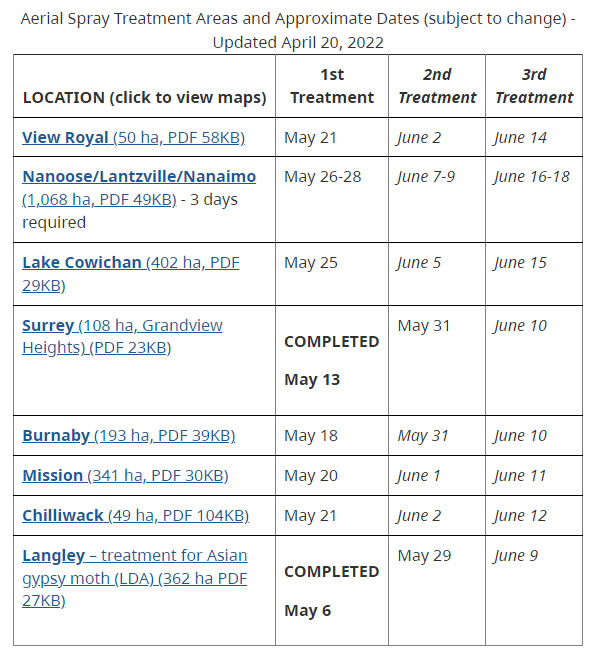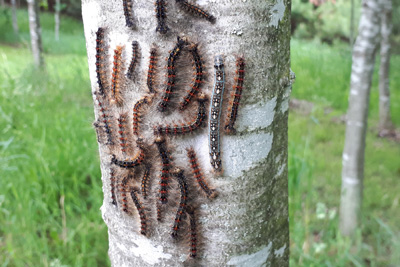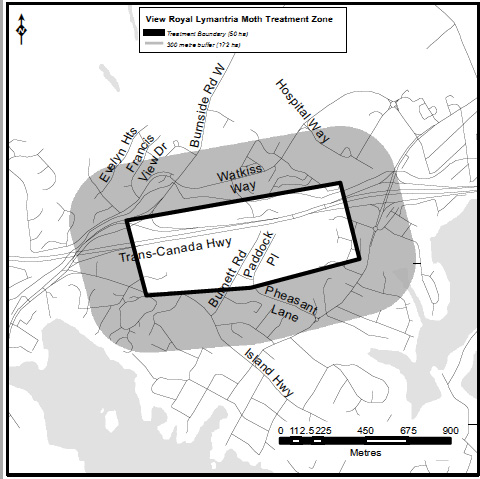Saturday April 30, 2022 | VANCOUVER ISLAND, BC [Updated May 16: spraying dates in View Royal now May 21, June 2 & June 14]
by Mary P Brooke | Island Social Trends
Aerial spray treatments for moths will be conducted on Vancouver Island beginning in early May.
These treatments will prevent lymantria moths, previously called gypsy moths, from becoming established and to minimize the risk they pose to forests, farms, orchards and urban trees.
The lymantria moth is an introduced pest. The caterpillars feed on tree leaves.
The BC Ministry of Forests released this news yesterday, April 29.

Three Vancouver Island treatment areas:
The planned 2022 treatment areas on southern Vancouver Island are:
* View Royal (50 hectares);
* Lake Cowichan (402 hectares); and
* Nanoose/Lantzville/Nanaimo (1,068 hectares).
These planned treatment locations are in addition to six areas on the Lower Mainland. Last year’s monitoring program trapped an above-average number of male moths on the Lower Mainland, indicating that the moths could become established in those locations if the proposed pesticide spraying is not done.

Introduced pest:
Trapping and monitoring results from 2021 show clear evidence that lymantria moth populations have increased dramatically in the areas slated for treatment this spring, likely as a result of outbreaks in Ontario and Quebec during the past three years.
Egg masses are commonly transported to B.C. on recreational vehicles and outdoor household articles originating from affected areas outside of the province.
These moths are unintentionally brought to B.C. on vehicles and equipment from eastern North America.
Trees at risk:
If left untreated, the invasive lymantria moths could spread to other areas of British Columbia.
Trees such as Garry oak, arbutus, red alder, aspen, cottonwood, maple, orchard fruit trees, nut trees and many species of urban ornamental trees would be affected, as well as food crops such as apples, blueberries and other fruits.
In recent years, large lymantria moth populations have defoliated sections of forests and residential areas in Ontario and the eastern United States.
Spraying early May to early June:
To control the moths, the ministry is planning as many as four applications of Foray 48B in the specified areas beginning in early May and ending in early June 2022. Organic farms in the spray area treated with Foray 48B will not lose their organic certification.
All aerial treatments will be conducted from first light (~5:30 a.m.) to as late as 8:30 a.m. The permit restricts those areas with public schools to be treated only until 7:45 a.m. on school days. Treatments will not be restricted to weekdays. Weekends, Statutory Holidays and Professional Development days can be treated until 8:30 a.m. Portions of some treatment blocks (Burnaby, South of Lougheed Hwy, Mission, North of Dewdney Trunk Rd., and Langley Township, North of Fraser Hwy) that do not contain schools will be allowed to be treated until 8:30 a.m.
Quarantines:
Infested locations are often subject to agriculture and transportation quarantines, as well as additional procedures that may include vehicle checks, product certification, and increased pesticide use.
Btk approved in 1961:
The active ingredient, Bacillus thuringiensis var kurstaki (Btk), is naturally present in urban, agricultural and forest soils throughout the province. It affects only the stomachs of caterpillars (e.g., lymantria moth caterpillars) and is specific to their digestive systems.
Approval was received by the Ministry of Forests to amend an existing pesticide use permit, issued in March 2021, for lymantria moths.
Btk has been approved for the control of lymantria moth larvae in Canada since 1961. It does not harm humans, mammals, birds, fish, plants, reptiles, amphibians, bees, or other insects. It only affects lymantria moth caterpillars after they have ingested it.
===== LINKS (provided by government):
- More about Lymantria moths: www.gov.bc.ca/lymantriamoth or call (toll-free): 1 866 917-5999
- Information about the pesticide use permit application or to see a map of planned treatment areas: www.gov.bc.ca/lymantria-news
- The amended pesticide-use permit and treatment area maps are also available for viewing at the city or municipal hall and/or on the websites of the affected communities.







